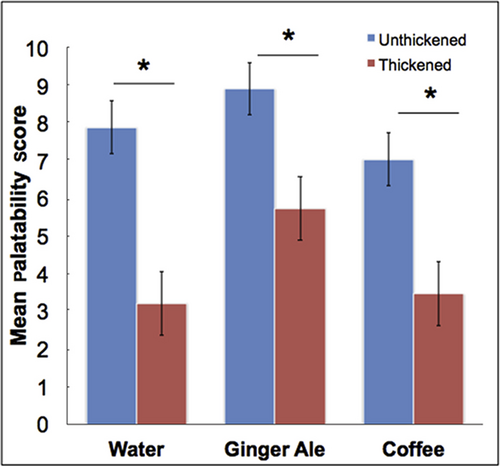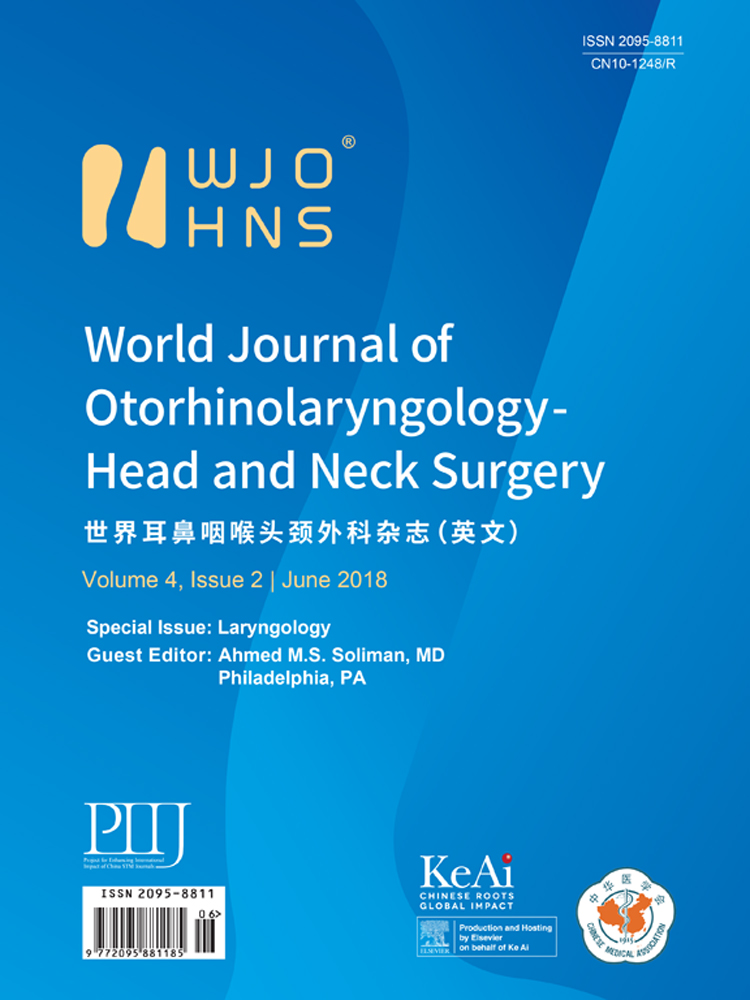Taste acceptability of thickening agents
Abstract
Objective
Patients with dysphagia are often unable to manage secretions and liquids, necessitating the use of commercial thickeners to decrease the likelihood of aspiration. This study aims to evaluate the effect of commercially available thickeners on hedonic perception of various liquids.
Methods
Forty subjects without preexisting dysphagia or anosmia were recruited from a tertiary care otorhinolaryngology clinic over a five-month period. Participants were presented with samples of three unthickened liquids (ice water, chilled ginger ale, and hot coffee) and their thickened counterparts and asked to rate the taste acceptability of the liquids on an 11-point visual analog scale. The study was reviewed by the hospital's Institutional Review Board and determined to be IRB exempt.
Results
A statistically significant preference for unthickened liquids over their thickened counterpart was observed across flavors (P < 0.0001). Of the thickened liquid samples, study participants expressed the strongest preference for thickened ginger ale.
Conclusion
Thickened liquids are perceived as significantly less palatable than their unthickened counterparts, although ginger ale may be better tolerated when thickened than coffee or water. Providers should be aware of the impact of thickeners on taste acceptability when counseling patients with dysphagia.
Introduction
Dysphagia represents a significant clinical challenge for patients with neurogenic swallowing disorders, the elderly, and those who undergo various treatments for head and neck cancers including surgery and radiation therapy.1 Many patients with dysphagia are unable to safely swallow liquids, and the rate of aspiration among patients treated with radiotherapy for head and neck cancer has been reported to be as high as 89%.2 Commercially available liquid thickeners may be used to reduce the risk of aspiration. Anecdotal evidence suggests that thickeners may alter the taste as well as the tolerability of liquids, but few formal studies have investigated this specific question.
Macqueen et al (2003)3 examined the taste acceptability of five different liquid thickeners in the UK and found that patients preferred certain thickeners over others irrespective of which type of liquid was thickened. In contrast, Pelletier (1997)4 examined the taste and consistency ratings of five different commercial thickeners across three different consistencies (syrup, honey, pudding) and found that no one thickener was superior to the others in consistency or taste. Horwarth et al (2005)5 investigated the taste preferences and ratings for two commercial thickeners and one natural thickener at the nectar-thick consistency for both hot and cold beverages and found that one natural thickener and one commercial thickener were superior to the other tested commercial thickener. None of these studies formally tested possible differences in the taste between thickened and unthickened liquids.
Adherence to a thickened liquid diet is critical to preventing aspiration and dehydration in patients with dysphagia. It is therefore important to better understand the acceptability of thickened liquids among patients in order to maximize adherence with treatment regimens. The primary objective of this study is to identify differences in taste acceptability between three different thickened and unthickened liquids with various flavor profiles in healthy adult participants.
Materials and methods
Participants
After Institutional Review Board review and exemption, study participants were recruited from a tertiary care otorhinolaryngology clinic. Those with pre-existing dysphagia or anosmia were excluded from the study. A total of 40 subjects were enrolled over a five-month period from October 2015 to February 2016. Subjects were stratified based on chronological age into a less than 55 age group and a 55 and older group in order to investigate the relationship between age and perceived palatability of thickened versus unthickened liquids.
Methods
Subjects were presented with six liquid samples, including unthickened samples of ice water, chilled ginger ale, and hot coffee, and the same liquids thickened to a nectar-like consistency using Thickit® (Milani Foods, St. Louis, MO), a commercially available liquid thickener of modified cornstarch and maltodextrin. In order to mitigate any ordering effects, subjects were randomized to receive either the thickened or unthickened samples first. After sampling each liquid, participants were instructed to rate the palatability of the sample on an 11-point visual analog scale, from 0 (unbearable, worst possible taste) to 10 (delicious, best possible taste) (Fig. 1).

Visual analog scale used to assess palatability of liquid samples.
Data analysis
For data analysis, JMP 12.1.0 was used at a significance level of P < 0.05. A paired-samples t-test was conducted to compare the scores assigned by study participants to unthickened and thickened liquids. Mean scores are reported with 95% confidence intervals.
Results
Forty subjects met the inclusion criteria and completed the study. Forty-five percent were male and 55 percent were female. Their ages ranged from 18 to 76 years with a mean chronological age of 49.5 years. Overall, participants demonstrated a significant preference for unthickened liquids over their thickened counterpart for each of the three sample liquids. For ice water, participants had a significant preference for unthickened water (M: 7.88, 95% CI: [7.17, 8.58]) over thickened water (M: 3.20, 95% CI: [2.35, 4.05]), t = 8.90, P < 0.0001. On average, participants ranked unthickened water 4.68 points higher than thickened water (95% CI: [3.61, 5.74]) (Fig. 2).

Perceived palatability of unthickened versus thickened samples of water, ginger ale, and coffee. Subjects (n = 40) assigned a subjective score to each sample, ranging from 0 (very unpalatable) to 10 (very palatable). Bars represent mean palatability scores. Error bars represent 95% confidence intervals. Asterisks indicate significant differences by paired t-test. ∗P < 0.0001.
For ginger ale, there was a significant yet smaller preference for unthickened ginger ale (M: 8.90, 95% CI: [8.55, 9.25]) over thickened ginger ale (M: 5.73, 95% CI: [4.92, 6.53]), t = 7.58, P < 0.0001. On average, participants ranked unthickened ginger ale 3.18 points higher than thickened ginger ale (95% CI: [2.33, 4.02]) (Fig. 2).
Participants reported a significant preference for unthickened coffee (M: 7.03, 95% CI: [6.10, 7.95]) over thickened coffee (M: 3.45, 95% CI: [2.52, 4.38]), t = 7.17, P < 0.0001. On average, participants ranked unthickened coffee 3.58 points higher than thickened coffee (95% CI: [2.57, 4.58]) (Fig. 2). The preference for unthickened liquids over the thickened counterpart remained statistically significant when subjects were stratified by age. No single study participant rated a thickened sample as more palatable than its unthickened counterpart.
Discussion
Liquid thickeners are commonly used to reduce the aspiration risk for patients with dysphagia. Prior studies suggest that the taste acceptability of thickened liquids can be influenced by the taste profile of the liquid, the degree of thickening, and the brand of commercial thickener being used.4, 5 However, to our knowledge, no studies have directly compared the taste acceptability of thickened versus unthickened liquids.
In this study, participants, regardless of age or gender, universally preferred unthickened liquids to liquids thickened with Thickit® (Milani Foods; St. Louis, MO) commercial thickener. Of the three thickened liquid samples, participants assigned the highest mean score to thickened ginger ale, and the smallest difference existed in perceived palatability between unthickened and thickened ginger ale. Participants assigned the lowest mean score to thickened water, and the greatest difference existed in perceived palatability between unthickened and thickened ice water. No difference was observed when subjects were stratified by age.
Horwarth et al tested the taste acceptability of thickened fruit juice and thickened hot chocolate and found that over 70 percent of study participants rated these thickened beverages as acceptable. However, the study tested only sweet liquids, and did not compare thickened to unthickened liquids. Our study suggests a near-universal preference for unthickened liquids over thickened liquids. Additionally, our results suggest that some liquids may be more palatable when thickened than others. Ginger ale was considered the most palatable thickened liquid, which suggests that sweet or carbonated liquids may be more tolerable when thickened. This is consistent with the previous studies where sweet liquids were more acceptable when thickened. The least palatable thickened liquid in our study was water, suggesting that flavorless liquids may be less tolerable when thickened. Our findings when taken with previous studies, suggest the importance of experimenting with various liquids, thickener brands, and consistencies to identify a combination that is most likely to encourage adherence.
This study has several potential limitations. First, the survey was conducted over a relatively small sample size of 40 subjects. Nevertheless, our results were statistically significant, reflecting the magnitude of our findings. Second, we presented only three liquids for sampling. The study was therefore not structured to detect subtle differences in liquids amenable to thickening. Finally, we included only subjects with normal swallowing function in our study. Additional studies should include study participants with dysphagia, the population that uses thickening products most frequently, to evaluate whether there are differences in preferences in this population.
Conclusion
Thickened liquids are perceived as significantly less palatable than their unthickened counterparts. Sweeter, carbonated liquids, such as ginger ale, are more acceptable to patients when thickened. Providers should work directly with patients to determine which liquids and consistencies are most tolerable in order to encourage adherence to a thickening regimen.
Financial disclosures
No financial relationships to disclose.




